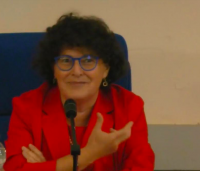A false digital identity
How many of the few good things arisen or grown as a result of the pandemic are destined to remain and how many will return to their exact previous state? Unfortunately there are several not-so-encouraging signs: traffic seems more chaotic than ever, in spite of the spread of work from home; so many strict behaviours that I thought were destined to dissolve little by little have returned in schools, from written themed essays in class to the oral tests that everyone is required to attend even if they have already been tested on that certain topic and even with a great performance. In Turin the most equal arrangement of the spaces in the Bet Hakeneset of the early days after the reopening in the spring of 2020 was abandoned and the women were sent back to the margins or to the matroneum (with the only partial exception, last year and yesterday, of the Neilà of Kippur for those who have chosen to place themselves in the external structure, a temporary tent that will certainly no longer exist when the emergency ceases).
Discussions on the presence of the crucifix in classrooms make up, as far as I know, another area in which these two years seem to have never existed. Yet, it is simply impossible, in this case, to put the question in the same terms it was put two years ago. As a matter of fact, it seems to me that neither the sentence of the Italian Supreme Court of Cassation or what was said later took into consideration the fact that a classroom is no longer merely a classroom, a limited physical place. It can, in fact, become a window on the world at any given moment: a window with a camera ready to be turned on to allow any student in quarantine to take part in the lesson. Also, a video-broadcast lesson can be easily recorded and re-transmitted. Therefore, teachers and pupils of any religion (Jewish, Muslim, atheist, etc.) risk not only being seen but also videotaped and retransmitted with a strong religious symbol behind or alongside them, which frankly seems as a rather serious abuse to me. And if, as stated in the sentence, the symbols of other religions were placed side by side with the crucifix, even Catholic teachers and students could have the same problem. There is much talk about the protection of digital identity, but in this case there is a more than concrete risk of imposing a false digital identity on a person. If it were to be produced, such digital identity would be substantially indelible, because the image could run for years and years, perhaps even completely decontextualized. I must confess that the idea scares me very much, even though fortunately there are no crucifixes in my school at the moment (but you never know what might happen). Of course, the students could, in a not-so-lawful yet not-so-impossible way, photograph me while I teach and artificially retouch my image by adding horns, a beard, a clown nose or who knows what else. But it would be, as I must emphasise, illegal, while the recording of a lesson in class is a perfectly legal thing and in certain situations it can even become a duty. Of course, you can solve the problem by paying a lot of attention to the angles and to the position of the religious symbols. However, it is clear that it would be much easier if they were not there at all, if not for ll the reasons that we have been listing for decades, at least for protection of digital identity of students and teachers.
I understand the desire for the previous state of things: it is the desire to regain, at least symbolically, an everyday life that has been taken away too abruptly. But returning to such a state is not always possible and in many cases it is not even desirable.
Translated by Gianluca Pace and revised by Alice Pugliese, students at the Advanced School for Interpreters and Translators of the University of Trieste, interns at the newspaper office of the Union of the Italian Jewish Communities.

